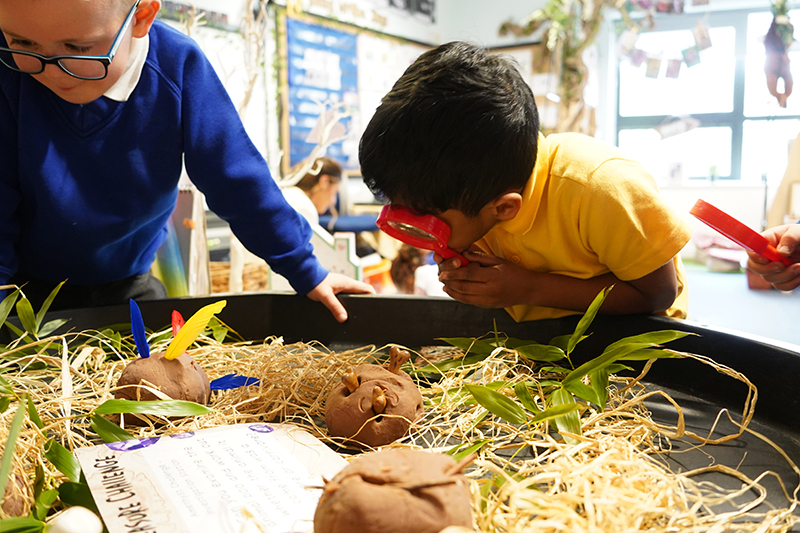Are you curious? I guess that you are because being a teacher requires a great deal of curiosity. Being curious means you like to learn, know why things happen and are fascinated by the world around you. It’s the same for children.
Natural Curiosity
From the moment they are born, children show their natural curiosity.
A 1964 study found that babies as young as two months old will point at things as if to say, ‘I want to know about that – what is it?’ As children enter their early years, their curiosity can become overwhelming for parents – so many questions!
In 2007, Professor Michelle Chouinard studied recordings of four children interacting with their parents and carers for two hours at a time, for over 200 hours. She found that, on average, the children asked more than 100 questions every hour.
That can be a bit much for any parent. But I’d rather my son ask too many questions than too few. Indeed, most of the projects in the Cornerstones EYFS Curriculum are based on questions he asked in his early years.
Why is curiosity important?
Curious people like to try new things and understand the world. They often have a greater sense of adventure. This means that they put themselves in situations that lead to rewarding experiences, from travelling to learning new skills.
There are health benefits to being curious too. Research suggests that a thirst for knowledge can stave off and prevent diseases, such as Alzheimer’s. The first point on the Alzheimer’s Association’s ‘Stay Mentally Active’ checklist even says, ‘Stay curious and involved – commit to lifelong learning.’
On the contrary, people who fear new things produce more cortisol, causing fat deposition, insulin resistance, a lazy immune system and muscle breakdown. Increased cortisol levels reduce overall life expectancy.
So staying curious, keeping an active mind and a desire to explore new things is very important. It makes us more interesting, happier, healthier people.
Curiosity in the classroom
Providing an environment and activities that promote and encourage children’s curiosity is vital. Curiosity crosses the skills versus knowledge agenda. It doesn’t discriminate. It covers both ‘things I want to know about’ and ‘things I want to be able to do’.
My 10 top tips for promoting curiosity in the classroom
1. Ask lots of questions
Have a bank of questions that you can turn to. Use them in class, for an independent inquiry, home learning ideas or even as the basis of a lesson. Questions can be open-ended and imaginative, such as, ‘Are elephants afraid of mice?’ or ‘What makes a good life?’ They can also be knowledge-based, for example ‘Are deserts always hot?’
2. Encourage children to
Give children the chance to ask about things that interest them by introducing a questions wall or box to your classroom. Can they collaborate to find answers and explore topics? Challenge older children to set their own home learning tasks by asking, ‘What else do you want to find out about this topic?’ Encourage them to use good question starters, such as, why, what, if and how.
3. Take a tip from the early years
Introduce an investigation area or ‘tinker table’ that includes random or themed items for children to handle and explore. Ask questions that relate to the objects such as, ‘What do they have in common? How are they different? What can you find out about the objects? How are they used?’ Can the children order the objects from the most to least interesting and explain why?
4. Offer things that change over time
Examples include frogspawn, eggs that hatch, food that decays and plants that grow. Observing changes over time gives children a sense of satisfaction that they want to repeat. They begin to understand real examples of complex biological processes. When children are confident about what they know, they are more likely to act on their curiosity – to explore, discover and learn.
5. Use the outdoor environment
Don’t confine learning to the classroom. Take a lesson outdoors to increase children’s sensory awareness and help them to experience things from different perspectives. Can they lay down and watch the clouds scoot by? What happens when they explore a hedgerow? Outdoor learning keeps children curious about the world around them and inspires creativity.
6. Books, books, books
Researching and reading online is great for finding information. However, having an excellent range of non-fiction books and encyclopaedias in your classroom or school library is vital too. It gives children access to knowledge that they can see, touch and refer to again and again.
7. Reward curiosity
Recognise curiosity when you see it. Praise children when they are curious by showing how their exploring and investigating helps them learn. Let them know that you value their motivation, no matter what they achieve.
8. Teach children
to be sceptics ‘Sceptic’ means ‘to inquire’ or ‘to look around.’ A sceptic needs evidence. Science and maths activities offer opportunities for being sceptical and can help children become willing to take on topics with an open mind. Use the mantra, ‘Let’s be sceptical!’ to fire up curiosity and send the message that things aren’t always as they seem.
9. Spread the curiosity
Create opportunities for the more curious children to work with the less curious in project-based learning activities. Curiosity is contagious.
10. Model curiosity
Model curiosity whenever you can. Share an interest, discovery or thought with the children. Why not investigate a shared question, where even you don’t know the answer? This will help you build an environment of trust that encourages everyone to be curious and where no one knows everything!
